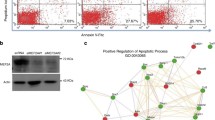Abstract
Angiotensin II (Ang II) exerts its effects by activating its receptors, primarily type 1 (AT1R) and type 2 (AT2R). While the role of AT1R activation in cardiomyocyte physiology is well known, the role of AT2R in cardiomyocyte apoptosis remains controversial. To define the precise role of AT1R and AT2R in this process, we transfected HL-1 cardiomyocytes with AT1R or AT2R cDNA, and examined markers of apoptosis. We found that AT1R overexpression was associated with upregulation of endogenous AT2R expression, but AT2R overexpression did not affect endogenous AT1R expression. Caspase-3 staining indicated that overexpression of AT1R as well as AT2R resulted in cardiomyocyte apoptosis with appropriate alterations in annexin V, Bax and Bcl2 expression. Overexpression of AT1R and AT2R markedly increased IL-1β (AT2R>AT1R), iNOS (AT2R>AT1R) and eNOS expression. AT2R-induced cell apoptosis could be blocked by the iNOS selective inhibitor 1,400 W, and did not require exogenous Ang II. These findings suggest that AT2R overexpression induces cardiomyocyte apoptosis, most likely via iNOS upregulation. AT1R-mediated cardiomyocyte apoptosis may be partially mediated by upregulation of endogenous AT2R.





Similar content being viewed by others
References
Whaley-Connell A, Habibi J, Cooper SA, Demarco VG, Hayden MR, Stump CP, Link D, Ferrario CM, Sowers JR (2008) Effect of renin inhibition and AT1R blockade on myocardial remodeling in the transgenic Ren2 rat. Am J Physiol Endocrinol Metab 295:E103–E109
Dandapat A, Hu CP, Chen J, Liu Y, Khan JA, Remeo F, Carey RM, Hermonat PL, Mehta JL (2008) Over-expression of angiotensin II type 2 receptor (AGTR2) decreases collagen accumulation in atherosclerotic plaque. Biochem Biophys Res Commun 366:871–877
Kurihara T, Ozawa Y, Shinoda K, Nagai N, Inoue M, Oike Y, Tsubota K, Ishida S, Okano H (2006) Neuroprotective effects of angiotensin II type 1 receptor (AT1R) blocker, telmisartan, via modulating AT1R and AT2R signaling in retinal inflammation. Invest Ophthalmol Vis Sci 47:5545–5552
Qi Y, Li H, Shenoy V, Li Q, Wang F, Raizada M, Sumners C, Katovich M (2012) Modulate cardiac-selective overexpression of angiotensin type 2 receptor protects cardiac functions from ischemic injury. Exp Physiol 97:89–101
Moudgil R, Musat-Marcu S, Xu Y, Kumar D, Jugdutt BI (2002) Increased AT2R protein expression but not increased apoptosis during cardioprotection induced by AT1R blockade. Can J Cardiol 18:1107–1116
Kong JY, Rabkin SW (2000) Angiotensin II does not induce apoptosis but rather prevents apoptosis in cardiomyocytes. Peptides 21:1237–1247
White SM, Constantin PE, Claycomb WC (2004) Cardiac physiology at the cellular level: use of culture HL-1 cardiomyocytes for studies of cardiac muscle cell structure and function. Am J Physiol Heart Circ Physiol 286:H823–H829
Chen HQ, Veluthakal R, Palanivel R, Kowluru A (2004) GTP-binding protein-independent potentiation by mastoparan of IL-1beta-induced nitric oxide release from insulin-secreting HIT-T15 cells. Apoptosis 9:145–148
Wang XL, Liu HR, Tao L, Liang F, Yan L, Zhao RR, Lopez BL, Christopher TA, Ma XL (2007) Role of iNOS-derived reactive nitrogen species and resultant nitrative stress in leukocytes-induced cardiomyocyte apoptosis after myocardial ischemia/reperfusion. Apoptosis 12:1209–1217
Hu C, Dandapat A, Chen J, Liu Y, Hermonat PL, Carey RM, Mehta JL (2008) Over-expression of angiotensin II type 2 receptor (AGTR2) reduces atherogenesis and modulates LOX-1, endothelial nitric oxide synthase and heme-oxygenase-1 expression. Atherosclerosis 199:288–294
Lu J, Wang X, Wang W, Muniyappa H, Hu C, Mitra S, Long B, Das K, Mehta JL (2011) LOX-1 abrogation reduces cardiac hypertrophy and collagen accumulation following chronic ischemia in the mouse. Gene Ther [Epub ahead of print]
Zhu L, Carretero OA, Liao TD, Harding P, Liu H, Sumners C, Yang XP (2010) Role of prolycarboxypeptidase in angiotensin II type 2 receptor-mediated bradykinin release in mouse coronary artery endothelial cells. Hypertension 56:384–390
Metcalfe BL, Huentelman MJ, Parilak LD, Taylor DG, Katovich MJ, Sumners C, Raizada MK (2004) Prevention of cardiac hypertrophy by angiotensin II type-2 receptor gene transfer. Hypertension 43:1233–1238
Matavelli LC, Huang J, Siragy HM (2011) Angiotensin AT2R receptor stimulation inhibits early renal inflammation in renovascular hypertension. Hypertension 57:308–313
Li H, Qi Y, Li C, Braseth LN, Gao Y, Shabashvili AE, Katovich MJ, Sumners C (2009) Angiotensin type 2 receptor-mediated apoptosis of human prostate cancer cells. Mol Cancer Ther 8:3255–3265
Tan NY, Li JM, Stocker R, Khachigian LM (2009) Angiotensin II-inducible smooth muscle cell apoptosis involves the angiotensin II type 2 receptor, GATA-6 activation, and Fasl–Fas engagement. Circ Res 105:422–430
Mehta PK, Griendling KK (2007) Angiotensin II cell signaling: physiological and pathological effects in the cardiovascular system. Am J Physiol Cell Physiol 292:C82–C97
Siragy HM, Jaffa AA, Margolius HS, Carey RM (1996) Renin–angiotensin system modulates renal bradykinin production. Am J Physiol 271:R1090–R1095
Siragy HM, Carey RM (1997) The subtype 2 (AT2) angiotensin receptor mediates renal production of nitric oxide in conscious rats. J Clin Invest 100:264–269
Tian B, Liu J, Bitterman P, Bache RJ (2003) Angiotensin II modulates nitric oxide-induced cardiac fibroblast apoptosis by activation of AKT/PKB. Am J Physiol Heart Circ Physiol 285:H1105–H1112
Andersson M, Poljakovic M, Persson K (2006) Caspase-3-dependent apoptosis in Escherichia coli-infected urothelium: involvement of inducible nitric oxide synthase. BJU Int 98:160–165
Ing DJ, Zang J, Dzau VJ, Webster KA, Bishopric NH (1999) Modulation of cytokine-induced cardiac myocyte apoptosis by nitric oxide, Bak, and Bcl-x. Circ Res 84:21–33
Sagoo P, Chan G, Larkin DF, George AJ (2004) Inflammatory cytokines induce apoptosis of corneal endothelium through nitric oxide. Invest Ophthalmol Vis Sci 45:3964–3973
Author information
Authors and Affiliations
Corresponding author
Additional information
X. Wang and J. Lu equally contributed to this paper.
Rights and permissions
About this article
Cite this article
Wang, X., Lu, J., Khaidakov, M. et al. Delineation of the effects of angiotensin type 1 and 2 receptors on HL-1 cardiomyocyte apoptosis. Apoptosis 17, 908–915 (2012). https://doi.org/10.1007/s10495-012-0721-6
Published:
Issue Date:
DOI: https://doi.org/10.1007/s10495-012-0721-6




